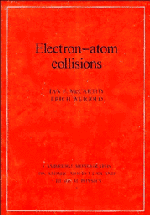Book contents
- Frontmatter
- Contents
- Preface
- 1 Introduction
- 2 Experimental techniques for cross-section measurements
- 3 Background quantum mechanics in the atomic context
- 4 One-electron problems
- 5 Theory of atomic bound states
- 6 Formal scattering theory
- 7 Calculation of scattering amplitudes
- 8 Spin-independent scattering observables
- 9 Spin-dependent scattering observables
- 10 Ionisation
- 11 Electron momentum spectroscopy
- References
- Index
2 - Experimental techniques for cross-section measurements
Published online by Cambridge University Press: 15 December 2009
- Frontmatter
- Contents
- Preface
- 1 Introduction
- 2 Experimental techniques for cross-section measurements
- 3 Background quantum mechanics in the atomic context
- 4 One-electron problems
- 5 Theory of atomic bound states
- 6 Formal scattering theory
- 7 Calculation of scattering amplitudes
- 8 Spin-independent scattering observables
- 9 Spin-dependent scattering observables
- 10 Ionisation
- 11 Electron momentum spectroscopy
- References
- Index
Summary
Quantitative studies of the scattering of electrons by atoms began in 1921 with Ramsauer's measurements of total collision cross sections. Ramsauer (1921) with his single-collision beam technique showed that electron–atom collision cross sections for noble gas targets pass through maxima and minima as the electron energy is varied, and can have very low minima at low electron energies. The marked transparency of rare gases over a small energy range to low energy (~1 eV) electrons was also noted by Townsend and Bailey (1922) in swarm experiments. This result was in total disagreement with the classical theory of scattering, which predicts a monotonic increase in the total collision cross section with decreasing energy. The Ramsauer–Townsend effect provided a powerful impetus to the development of quantum collision theory.
Although the history of electron impact cross-section measurements is quite long, the instrumentation and the experimental techniques used have continued to evolve, and have improved significantly in recent years. Part of the motivation for this progress has been the need for electron collision data in such fields as laser physics and development, astrophysics, plasma devices, upper atmospheric processes and radiation physics. The development of electron–atom collision studies has also been strongly motivated by the need of data for testing and developing suitable theories of the scattering and collision processes, and for providing a tool for obtaining detailed information on the structure of the target atoms and molecules and final collision products.
- Type
- Chapter
- Information
- Electron-Atom Collisions , pp. 4 - 49Publisher: Cambridge University PressPrint publication year: 1995

